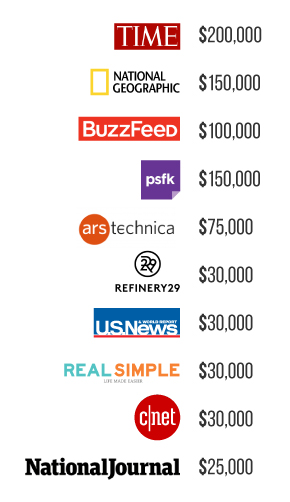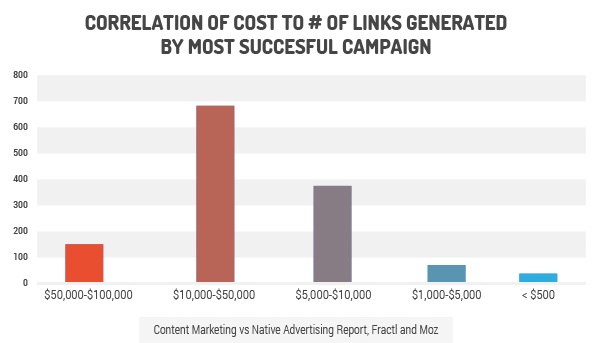| The Reach, Engagement, and ROI of Content Marketing vs. Native Advertising (New Research) Posted on: Tuesday 05 May 2015 — 02:16 Posted by KelseyLibert As the efficacy of outbound marketing continues to wane, more and more marketers are considering native advertising and content marketing as viable alternatives. According to our survey, 72% of clients have asked their content marketing agencies about native advertising.
While these two strategies have many similarities, one of their major differences is cost. Based on new exclusive research conducted by Fractl and Moz, these top-tier publishers require the following minimum spend to produce native advertising campaigns for brands:
MethodologyThe goal of our research was to take a data-driven approach to comparing the efficacy of native advertising versus content marketing. For the first part of our study, we created a 14-question survey for content marketing providers which explored everything from the cost of their services to the reach of their campaigns. Our friends at Relevance were kind enough to offer the raw data on their native advertising cost research as well, allowing us to focus on gathering additional cost data from the top-tier publishers we maintain relationships with. After we received the survey responses from over 30 different content marketing agencies and cost data from close to 600 digital publishers, we began our analysis.
I. Identifying marketing objectives and challenges in the digital ageBefore we dive into our findings, it's important to know the collective objectives and challenges of the inbound marketing age. Since Fractl and Moz spearheaded this study, we wanted to use an authoritative third-party source to support our research and set the stage for our discussion. For that, we'll refer to HubSpot's State of Inbound 2014–2015 Report. The four graphs below shed light on marketing's key objectives, challenges, and wins. 1. The top 60% of marketing objectives focus on increasing leads, converting customers, and reaching relevant audiences.
2. The number one challenge marketers report is proving the ROI of their marketing activities.
3. SEO is the number one lead-generating source reported by inbound marketing professionals.
4. The companies with the highest ROI focus on blogging, organic search, and content amplification.
Right out of the gate we see that content, organic search, and content amplification are leading the way for marketers, priming content providers and promoters for exponential growth.
So how does content marketing compare to native advertising? II. The landscape of content marketing and native advertising opportunitiesThe bullhorn of radio, television, print, and other one-way interruptive marketing approaches are quickly losing efficacy, allowing content marketing and native advertising to step in and solve the following problems:
But what are the major differentiating factors between content marketing and native advertising?
Both content marketing and native advertising can be used to generate brand awareness and engagement. While top-tier publishers sell themselves on their large, built-in reach, sponsored content doesn't guarantee engagement. Below, we created a Buzzsumo analysis of 38 BuzzFeed native advertising campaigns in comparison to 58 Fractl content marketing campaigns. The BuzzFeed campaigns were calculated using all of the posts on a "Brand Publisher's" page (e.g. Kindle); while the Fractl campaigns were calculated using all of the campaigns executed for each of our client's during 2014.
At Fractl, we've earned an average of 90 links and 10,000 social shares per campaign, across 140 different campaigns executed between 2013 and 2015. In comparison, with native advertising, you're often just paying for the ability to publish content solely on the site you're partnering with. Although BuzzFeed boasts monthly traffic numbers in the multi-millions, this doesn't guarantee social engagement nor syndication of a campaign, as seen above.
Further into our research, you'll see that that content marketing agencies are doing the additional legwork with influencer marketing to amplify their content, which creates a larger reach than most top-tier publishers offering native advertising. Furthermore, content marketing results directly impact a client's organic search positioning, whereas native advertising is limited by Google's guidelines:
Has the cost of native advertising been inflated as a means of recovering revenue, or is it truly worth the tens of thousands of dollars that top-tier publishers are charging?
Let's dig further into the numbers to find out. III. Cost analysis of the native advertising industryBased on HubSpot's report, 93% of companies with an annual marketing budget between $1 and $5 million are practicing inbound.
Estimates from BI Intelligence show that spending on native ads will reach $7.9 billion in 2015 and grow to $21 billion in 2018, rising from just $4.7 billion in 2013.
But can most businesses afford the exorbitant costs for native advertising on top-tier publishers? Is the ROI worth it? Using native advertising cost data gathered by Relevance and Fractl, we analyzed the cost of native advertising on general news publishers with a domain authority (DA) greater than 80 and a social following greater than 100,000 – highly sought after placements for most brands. The average cost of launching a native advertising program with a top-tier news publisher was $54,014.29. The highest cost was $200,000.
When we expanded our analysis to include all publishers who have a DA greater than 80, we found the average cost of launching a native advertising program was $35,482.50*. *Average value derived from original cost totals and not the averages displayed in the image above.
When we evaluate all publishers and blogs below a DA of 80, we see the less valuable publishers (lower reach) offer a significantly reduced cost. For sites with a DA less than 80, the highest cost was $20,000 and the lowest cost was $10.
As outlined above, native advertising cost is largely associated with authority and reach. However, since engagement isn't a guarantee and the costs can be exorbitant for most brands, there's a need for other options that leverage and amplify content. IV. Analysis of the efficacy of content marketingThrough our exclusive survey of over 30 content marketing agencies, we discovered how the content marketing landscape compares to native advertising. 1. 70% of content marketing agencies offer monthly retainers. The industry is largely dominated by retainer packages, which often include production on multiple campaigns, influencer marketing, and on-site/overall strategy consultation. As represented in this pie chart, the pay-per-word structure is quickly eroding, and more comprehensive inbound marketing strategies are taking its place.
2. Retainers tend to fall into four buckets: $1,000–$5,000, $5,000–$10,000, $10,000–$50,000, and $50,000–$100,000. Of all of our questions, this answer had one of the most evenly balanced responses, which demonstrates that there is a content marketing package that almost every business can afford. Similar to the native advertising scale, content marketing costs largely relate to the scope of the projects being produced (e.g., press releases versus interactive graphics) and their reach (e.g., influencer marketing versus no outreach). 3. On average, 65% of agencies produce between 1 and 10 campaigns per month for each client. With content marketing campaigns, success is largely determined by a portfolio of executions: it's natural to have some campaigns flop for reasons outside of your control (i.e., poor publisher headlines, trending stories monopolize news, etc.), but over a portfolio of executions (i.e., three- to six-month retainers), most agencies can guarantee a base level of success.
4. Articles and infographics represent almost 60% of production, with case studies, interactive graphics, and videos accounting for close to 30% of production. Based on our previous survey of 500 top-tier publishers, we found that articles and infographics were the most sought after content formats, so it's good to see most agencies are producing what's in-line with the publishers that will give them the largest reach.
5. Excluding outliers, the average content marketing campaign earns 27 links. Across 38 native advertising campaigns produced by BuzzFeed, only eight backlinks were earned – an average of 0.18 backlinks per campaign. If you include the BuzzFeed article itself as a pickup (like we did in section II), you'll get an average number of campaign pickups of 1.18.
6. The average for each agency's "most successful campaign" is 422 links and the median is 150 links. Again, we see a fairly even split with this response, likely relating back to the even split we saw with the monthly retainer.
7. Does agency cost correlate to performance? Here, we see the sweet spot for success comes from agencies that are given the budget to produce larger-scope campaigns and invest in influencer marketing – those charging $5,000 to $50,000 per content marketing campaign or retainer.
8. 48% of clients measure content marketing success by the number of leads, high-quality links, and total social shares generated by each campaign. Remember, marketing professionals listed two top objectives: increasing the number of leads and reaching the relevant audience. With content marketing, this translates directly into the number of leads generated from high-quality links/placements, and reaching the relevant audience translates into total social shares/engagement on a targeted campaign.
9. 39% use DA to evaluate the authority of a link. While 39% of agencies use DA to evaluate the authority of a link, an almost equal number of agencies (35.7%) aren't tracking link authority. This is interesting, considering high-quality links were reported as the number two metric for content marketing success; however, high-quality links only accounted for 14.3% of the total pie, so DA might only be tracked by the agencies that have the budget to produce campaigns that earn high-quality links.
V. The ROI of content marketing vs. native advertising |
| You are subscribed to the newsletter of Moz Blog sent from 1100 Second Avenue, Seattle, WA 98101 United States To stop receiving those e-mails, you can unsubscribe now. | Newsletter powered by FeedPress |
| FeedPress is a service edited by Beta&Cie, www.betacie.com | |















































